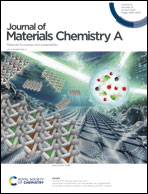Doping-induced grain refinement contributes to enhanced thermoelectric performance of n-type PbSe at room temperature†
Abstract
Grain refinement is a successful strategy to depress lattice thermal conductivity and improve the performance of thermoelectric materials, while it often requires complex processing techniques. Here, we report a striking approach, involving the alloying of GeS and Cu doping to induce the formation of grain boundary phases and reduce grain size in n-type PbSe. This is a successful strategy to effectively increase the scattering of phonons of grain boundaries and grain boundary phases, leading to a significant reduction in lattice thermal conductivity over the entire temperature range. Additionally, the introduction of interstitial Cu enables self-optimization of carrier concentration over the whole temperature range, which significantly improves the power factor combined with the increase of the electron effective mass. As a result, a room-temperature zT of 0.5 and ultralow lattice thermal conductivity are achieved for n-type Cu0.004(PbSe)0.9(GeS)0.1. This work provides a unique strategy for enhancing thermoelectric properties through doping-induced grain refinement.



 Please wait while we load your content...
Please wait while we load your content...